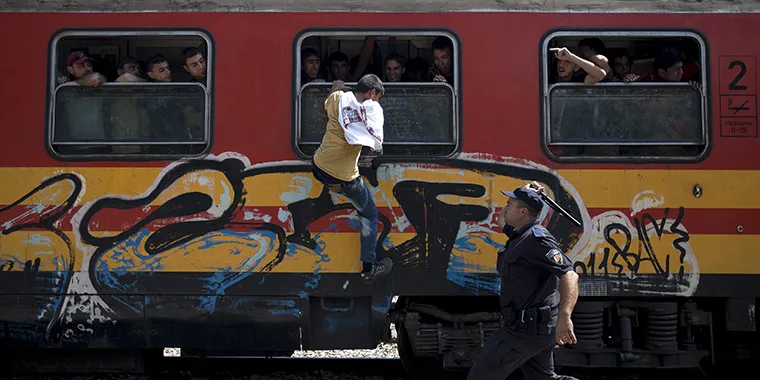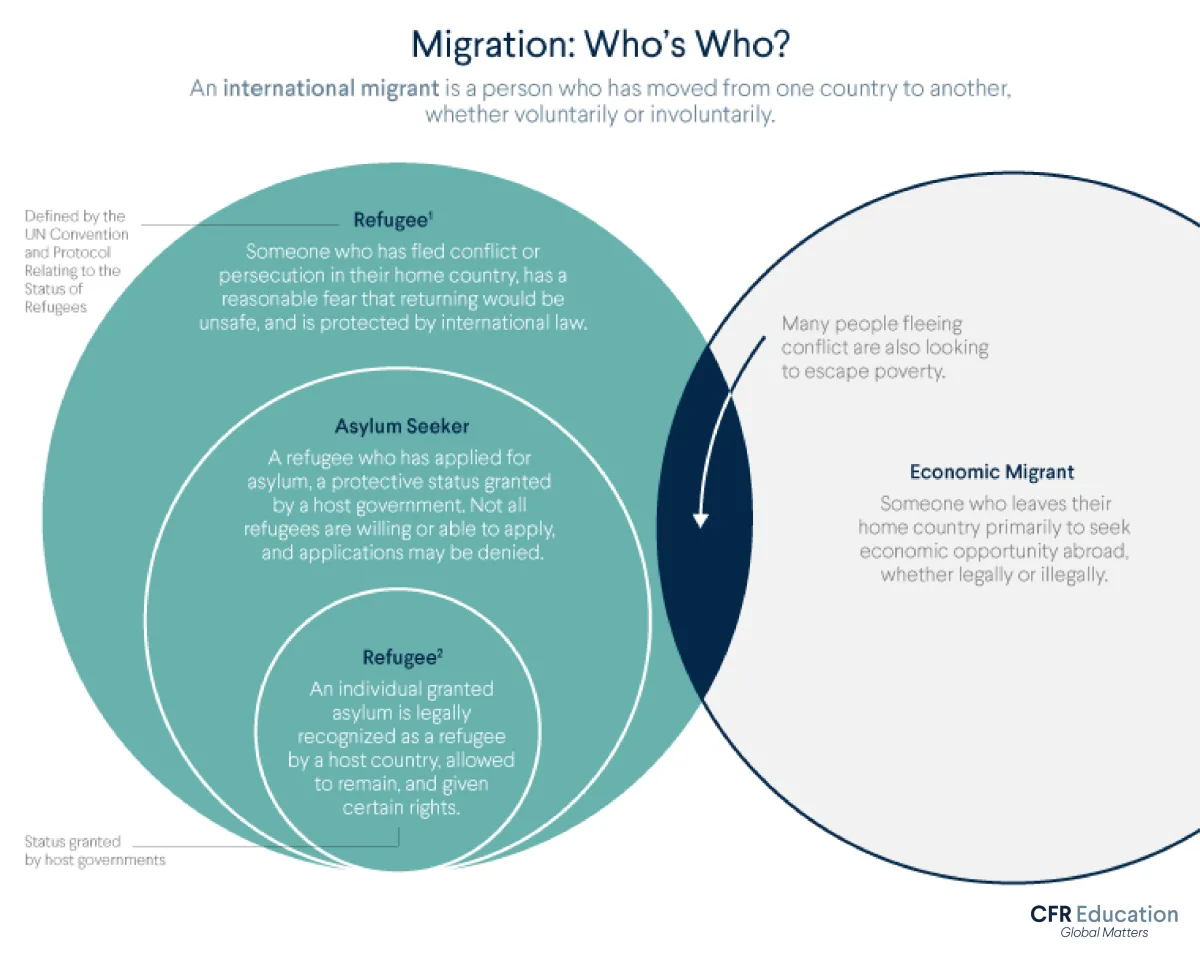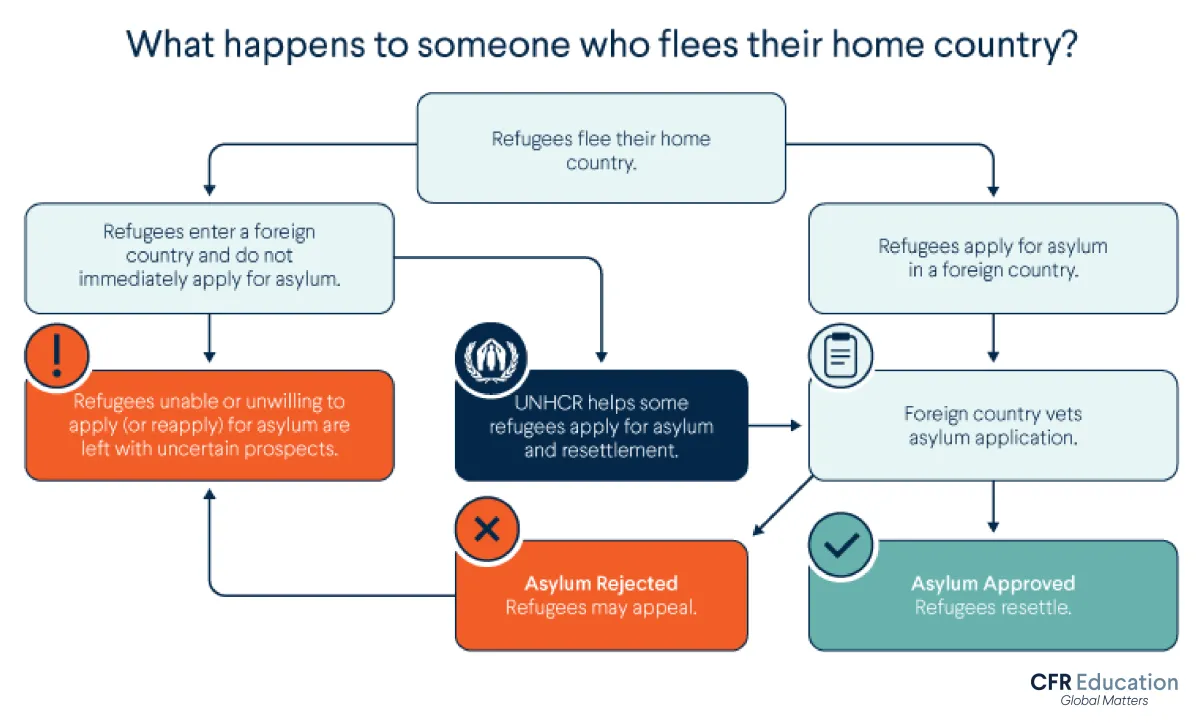For Migrants, Labels Matter
What is the difference between immigrants, refugees, and asylum seekers? Explore how contested definitions of migrants have a profound effect on the rights and protections of people leaving their homes.
Migration has shaped human history since the beginning of time. As politics and society have evolved, so too have the terms we use to understand and govern human mobility.
What is immigration? What is migration?
Although definitions differ, a prominent definition from the International Rescue Committee (IRC), an international humanitarian aid organization, of a migrant is someone who is moving from place to place (within their country or across borders), usually for economic reasons such as seasonal work.
An immigrant is a type of migrant who makes a conscious decision to leave their home and move to a foreign country to settle there. Immigrants often undergo a lengthy vetting process to immigrate to a new country, many of whom become lawful permanent residents and eventually citizens.
People who relocate from one country to another are generally known as international migrants. This umbrella term covers both economic migrants and refugees. Economic migrants leave their homes seeking better economic opportunities. Refugees flee their home countries due to conflict or persecution and fear for their safety if they return. These distinctions are important because different migrants are entitled to different rights and protections from host governments and international organizations. However, the reasons why people migrate can often overlap, presenting a challenge to policymakers.
At a time when migration is rising and immigration is heavily politicized, it’s important to understand what drives people to migrate and what these designations really mean.
Who is an economic migrant?
Economic migrants are seeking job opportunities abroad. Economic migrants, who account for the majority of the world’s migrants, broadly fall into two categories: those who are authorized to work in the country they migrate to and those who are not.
Legal Immigrants
In most cases, immigrants need permission to live and work in their new country. Many economic migrants obtain that permission by applying for a visa or going through other processes set up by the host country. Once granted permission, they enjoy some rights to live and work in the host country.
Undocumented Immigrants
When people migrate to a country without the permission or authorization of that country’s government, they can be deprived of those same rights. These migrants can find themselves in precarious situations. These migrants are called by different names, often for political effect: undocumented immigrants, irregular migrants, and illegal aliens.
Who is a refugee? Who is an asylum seeker?
Many migrants are forced to leave their homes because of conflict, persecution, or natural disaster. As of the end of 2020, refugees and asylum seekers together accounted for approximately 12 percent of global migrants. And, as of 2022, the IRC estimates that there are 82 million people escaping war, persecution and political turbulence.
So, who decides which migrants receive refugee status? The distinction between economic migrants with and without work authorization is straightforward. However, the line between an economic migrant and a refugee is often blurred, since many people fleeing conflict, for example, often are also looking to escape poverty. To complicate matters, governments, international organizations, and communities often disagree on who counts as a refugee. This can result in the uneven treatment of refugees worldwide.
Refugees
The UN Refugee Convention defines a refugee as any person who owing to well-founded fear of being persecuted for reasons of race, religion, nationality, membership of a particular social group or political opinion, is outside the country of his nationality and is unable or, owing to such fear, is unwilling to avail himself of the protection of that country; or who, not having a nationality and being outside the country of his former habitual residence as a result of such events, is unable or, owing to such fear, is unwilling to return to it.
146 nations agree to this definition. However, host governments ultimately get to decide whether to recognize someone as a refugee. This protective status is known as asylum.
Asylum Seekers
When migrants request that a host government recognize them as a refugee, they are called asylum seekers. If the host government grants those migrants asylum, they are referred to as asylees. Once granted protective status, asylees receive the protection that comes with an official refugee status. These protections may include the right to work, access to education, and health care. Moreover, refugees are provided the rights and freedoms afforded to citizens and legal residents of that country.
What is the difference between a refugee and an asylum seeker?
Both refugees and asylum seekers are fleeing for their safety. However, the distinction between these two, though seemingly small, makes a big difference in how they are treated by governments and international organizations.
For example, the U.S. government distinguishes refugees from asylum seekers and asylees based on where and when they apply for protective status. Refugees, according to the U.S. government, are located outside the United States at the time of application; asylum seekers, on the other hand, apply when they arrive at the U.S. border or shortly thereafter. These distinctions can have a major impact on the rights and protections of migrants.
By contrast, the United Nations considers migrants who flee war and persecution to be refugees. This label carries weight regardless of whether migrants have requested or been granted asylum by a host country. That means, for example, that the United Nations grants fleeing Syrians and Eritreans refugee status prima facie, or automatically.
How do refugees seek asylum?
Seeking asylum is a lengthy and difficult process. Every migrant, regardless of whether they entered a country legally, has the right to apply for asylum. However, the application process—including how to apply and in which country—can be difficult, confusing, and time-consuming. For instance, in the United States, the asylum process can take several years.
Some countries, such as the United States, Canada, and most European Union (EU) member states, require people to apply for asylum in the first (or first safe) country in which they arrive.
In the European Union, for example, a law called the Dublin Regulation establishes which EU member state is responsible for examining an asylum application submitted by someone who is not an EU citizen. Generally, according to the rule, the EU country where the asylum seeker first arrives is responsible for processing the application. This system ensures that each case is processed by only one government. If asylum seekers register in one EU country and then travel to another, they can be sent back to the first country in a “Dublin transfer.”
Countries can waive the first-entry rule, signaling a willingness to take in refugees who arrive in another country first. This, however, can create a “hot potato” effect in the EU, whereby the first country to receive refugees tries to quickly pass them on to another.
Negotiations between and among governments can also directly affect where refugees or asylum seekers end up. Since the U.S.-Canada Safe Third Country Agreement went into effect in 2004, most people who arrived in the United States but tried to cross into Canada and apply for asylum there were sent back to the United States. These migrants had their asylum cases considered under U.S. law.
In yet another example of international negotiation, the EU and Turkey struck a deal in 2016 that would allow the EU to send back “all new irregular migrants” who entered Greece through Turkey. In exchange, the EU agreed to grant Turkey economic aid, allow visa-free travel to most of Europe for Turkish citizens, and, for each returned Syrian from Greece, accept one Syrian refugee from Turkey who hadn’t already tried to enter the EU.
What happens to refugees if their asylum claim is denied?
Whether for political, economic, or other reasons, host countries deny many asylum seekers’ applications, leaving them with few options. These refugees remain in limbo, go back to their home countries, or head to a new country.
Not every refugee applies for asylum. Assimilating into an entirely new country and culture can prove extremely difficult, so many refugees just wait to return home instead. These refugees—as well as those with pending asylum claims and others who are unable or unwilling to apply—often remain in refugee camps without the right to work and can face great insecurity and hardship.
For refugees fleeing violence and persecution, an already precarious situation can become uncertain and dangerous on the path to asylum. The situation is even more precarious for those who do not seek, or are denied, that status. COVID-19 further compounded these difficulties, as migrants faced increased travel restrictions that narrowed their already limited options.



